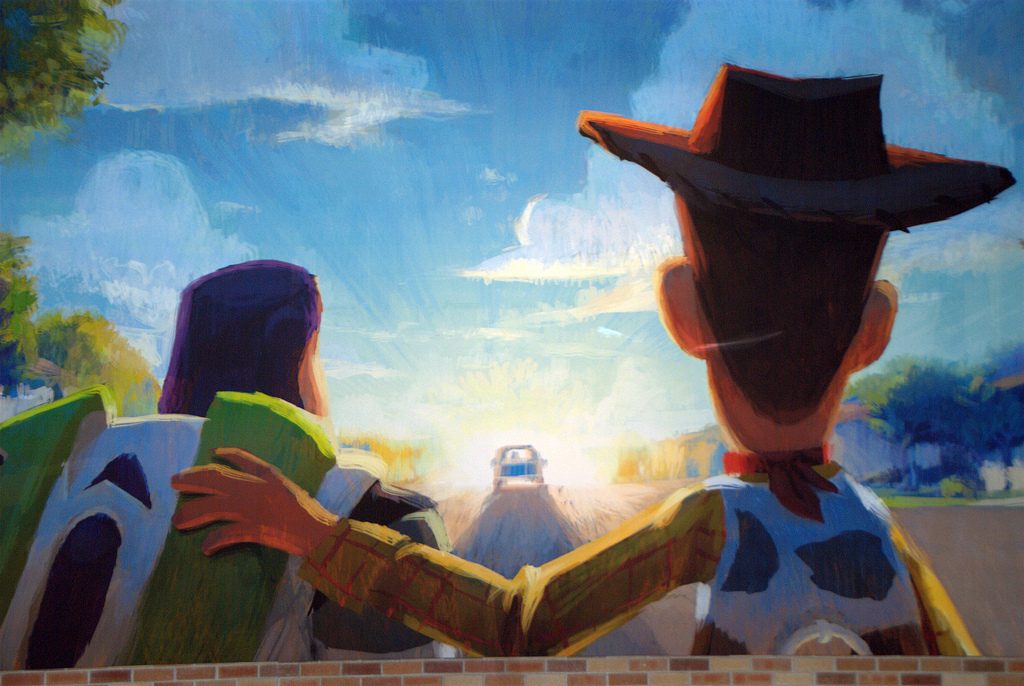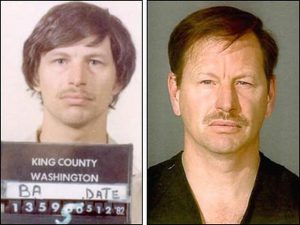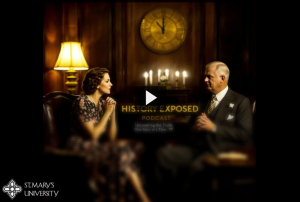Winner of the Fall 2018 StMU History Media Award for
Article with the Best Title
Best Article in the Category of “Cultural History”
“It felt like it had taken a lifetime to get to this point, and in a sense it had.”1
Most of us grew up in a world where toys came to life when Andy wasn’t looking, a world where the monsters in our closet were afraid of us, a world where houses could fly with balloons. Pixar movies have created a world of magic and infinite possibilities. They have brought life and authenticity out of technology. Pixar has created a cinematographic empire like no other. Their success was forged out of mistakes and struggles as well as passion, creativity, and determination. Pixar had to make mistakes in order to grow and create the stories we love today, and they did.
Pixar’s story really starts with three men: Edwin “Ed” Catmull, Steve Jobs, and John Lasseter.

Ed Catmull was turned down for a teaching position and felt he had landed a software development job with no future. Steve Jobs had been humiliated throughout Silicon Valley when Apple Computer, the company he founded, fired him.2 John Lasseter was fired from his dream job as a Disney animator for trying to introduce three-dimensional animation technology there. He was told that if it didn’t make movie production cheaper or faster, it wasn’t worth it.3 All of these men were at a low point in their lives when they became part of the group of people that eventually became Pixar. What brought them out of this uncertain part of their lives was a single goal: to change the way stories are told by pushing the boundaries of what computers can do in animation and graphics by creating the first computer-animated movie in history. These people became the foundation of Pixar Animation Studios.
Not commonly remembered is the company’s inception as the Computer Graphics Division for Lucasfilm, the movie studio behind the Star Wars franchise, beginning in 1979. Through a series of events, Steve Jobs ended up buying this small struggling division in 1986 for five million dollars. He also gave it its iconic name. At that point, the company was selling computer hardware with the Pixar Image Computer as their main product. Their increasingly dwindling revenue also consisted of producing commercials for companies such as Trident and Listerine.4 With their financial struggles, and no clear path into the future of movie-making, Pixar was created.
Pixar’s goal moved further out of reach as they fired one-third of the company in 1991. At that point, Pixar had only sold three hundred Pixar Image Computers. They then decided to stop selling hardware. The five million dollars it had cost Jobs to buy the company had turned into a $54 million money pit. Its only source of revenue, and future survival, was a contract with Disney to produce three movies. There wasn’t even a guarantee that they could make the movies. Nevertheless, the team decided to take a leap of faith into the unknown path of creating computer-animated movies.5
Money was tight and there was constant miscommunication between the Pixar team and Jobs. Jobs was in the middle of establishing NeXT, a computer company he started after Apple. This meant that he rarely appeared in the Pixar offices. The Pixar team felt Jobs did not understand what they needed, and Jobs felt that the Pixar team had no idea how to run a business. Lasseter and Catmull would put out an idea and Jobs would shut it down immediately: the only way was his way. Jobs was described as brilliant and inspirational as well as dismissive, condescending, and bullying. It was clear, Pixar could not survive under Jobs. He simply did not connect with the company leadership and staff, but the company could not survive without him either.6

From the year 1987 to 1991, Jobs attempted to sell Pixar three times. Catmull reflected on this time, saying, “Even if Pixar doubled in value, Steve told me, we still wouldn’t be worth anything.”7 Microsoft, Alias, and Silicon Graphics all tried to acquire the company, but Jobs never sold it. Despite taking millions of dollars of his own money just to keep it afloat, he could not sell. It was his way of saying that he had something other people wanted, something special, that Pixar was worth having, despite its flaws. Every time a company made an offer for Pixar, he acted insulted, suggesting that he believed Pixar was worth much more. It was only after critics predicted that an animated film would be a hit and that Disney signed with Pixar to make their movie, that Jobs gave Pixar one last chance.8
There emerged some hope, as they assembled an excellent but inexperienced team in 1992. Catmull and Jobs began to understand each other and collaborate, and the first computer-animated movie was in its beginning stages. Production of the movie began in early 1993. Their dream was so close that they could see it; their dream was becoming a reality. Their first movie blossomed from Lasseter’s simple idea, the story about a group of toys and a boy.9
Toy Story was going to create a revolution within the technology, art, animation, and entertainment fields. Because this was going to be their debut film under their “mentor” company Disney, Pixar story writers took every advice they gave them to heart. Disney animators were the experts, and they had the success Pixar craved. Disney perceived Woody, a toy cowboy and one of the movie’s main characters, as “too perky, too earnest.”10 An edgier Woody would create a better conflict and a better story. Or so they said.
November 19, 1993 came. It was also known as “Black Friday.” On this day, a mock-up of Toy Story was presented to Disney executives. Months of hard work had been dedicated to making this idea become a reality, and finally … Disney shut down the project. There would not be an animated movie until they fixed the script.
They had technology and talent, but the entire concept was just not right. Something crucial was missing. For the next couple of months Lasseter, Catmull, and the entire team worked every possible moment to rediscover the soul of the project. By this time, special effects were starting to enter mainstream cinematography, with movies such as Jurassic Park and Terminator 2. People enjoyed the manner in which technology enhanced the movie experience, and Pixar was ready to be part of this innovation wave.

The answer to their story problem was simple. They hit on the idea of a story of a boy and his toy cowboy. This experience taught them to trust their own abilities, to give Pixar its own character, and to do things the Pixar way.11
November 22, 1995. Toy Story was released to the world, to infinity and beyond.12
In total, Toy Story earned $362 million worldwide, it was a phenomenon. It had created an ingenious and creative new storytelling method. Now the graphics on the movie screen were perceived as having emotion and character. The movie had characters that had life in a way that was unprecedented from anything animators had done before. Pixar was able to create this emotional response because the overall theme was so human and relatable. With themes such as friendship, change, finding who you truly are, and your purpose in life, it is no surprise that though this movie was made for a young audience, it resonated with people of all ages. It was a masterpiece.13
The following year, Toy Story was nominated for three Academy Awards. John Lasseter received a Special Achievement Award. And Pixar announced its retirement from making commercials in order to focus on making more movies.
Due to its success with Toy Story, Disney pursued a partnership with Pixar. Shortly afterward, Pixar decided to open their company stock to the public. With this, they earned $140 million for the company. Pixar had accomplished something it had never done before; it was now a stable company.14
What started off as a constantly struggling company became an animation empire. Their stories have since touched the lives and hearts of people around the world. They’ve made us cry and they’ve made us laugh. Ed Catmull, Steve Jobs, and John Lasseter came together to change the world by creating the first computer-animated movie.
The rest is history.
- Edwin Catmull and Amy Wallace, Creativity, Inc.: overcoming the unseen forces that stand in the way of true inspiration (New York: Random House, 2014), 56. ↵
- David A. Price, The Pixar Touch: The Making of a Company (New York: Vintage Books, 2009), 8. ↵
- Bill Capodagli and Lynn Jackson, Innovate The Pixar Way: Business Lessons from the World’s Most Creative Corporate Playground (New York: McGraw-Hill, 2009), 31. ↵
- “Our Story,” Pixar, accessed August 31, 2018, https://www.pixar.com/our-story-1#our-story-main. ↵
- Edwin Catmull and Amy Wallace, Creativity, Inc.: overcoming the unseen forces that stand in the way of true inspiration (New York: Random House, 2014), 53. ↵
- Edwin Catmull and Amy Wallace, Creativity, Inc.: overcoming the unseen forces that stand in the way of true inspiration (New York: Random House, 2014), 51-52. ↵
- Edwin Catmull and Amy Wallace, Creativity, Inc.: overcoming the unseen forces that stand in the way of true inspiration (New York: Random House, 2014), 54. ↵
- Edwin Catmull and Amy Wallace, Creativity, Inc.: overcoming the unseen forces that stand in the way of true inspiration (New York: Random House, 2014), 53; “Our Story,” Pixar, accessed August 31, 2018, https://www.pixar.com/our-story-1#our-story-main. ↵
- Edwin Catmull and Amy Wallace, Creativity, Inc.: overcoming the unseen forces that stand in the way of true inspiration (New York: Random House, 2014), 54. ↵
- Edwin Catmull and Amy Wallace, Creativity, Inc.: overcoming the unseen forces that stand in the way of true inspiration (New York: Random House, 2014), 57. ↵
- Edwin Catmull and Amy Wallace, Creativity, Inc.: overcoming the unseen forces that stand in the way of true inspiration (New York: Random House, 2014), 57. ↵
- “Our Story,” Pixar, accessed August 31, 2018, https://www.pixar.com/our-story-1#our-story-main. ↵
- David A. Price, The Pixar Touch: The Making of a Company (New York: Vintage Books, 2009), 151. ↵
- Edwin Catmull and Amy Wallace, Creativity, Inc.: overcoming the unseen forces that stand in the way of true inspiration (New York: Random House, 2014), 60. ↵



201 comments
Megan Copeland
This was such a good article. Growing up I watched a ton of Pixar movies, and loved almost every single one of them. One thing that I was not aware of was that Steve Jobs played a huge role in Pixar. I liked the pictures that were used in the article. One of my favorite Pixar movies has always been Toy Story, and ever since I saw it, I have always been a fan of the company. I think Pixar has played an important role of many children around the world growing up.
Sofia Andrade
Growing up I saw many of the Pixar movies, I simply enjoyed the movies without their creation ever crossing my mind. This once struggling company created some of my favorite movies. I would not like to imagine a world without Pixar movies. I am glad that throughout their struggles Pixar was able to thrive. Through their success a different form of film making was able to spread.
Emily Jensen
I remember watching all the Pixar movies that I could get my hands on when I was little. It was very interesting to read that Toy Story was really Pixar’s big break. The constant struggle that the company went through in order to keep going was incredible, and what a payoff for them! This was a great read, would definitely recommend!
Andrea Cabrera
I love reading articles about the early struggles of Disney. I found it very interesting to know that Pixar wasn’t as successful when they first started out considering how huge in it is around the world. This article was filled with all new information to long time fans like me. I feel it is so cool that their big break was a movie I’ve watched multiple times since I’m a little girl. Congratulations on the article!
Andrea Cabrera
I love reading article’s about the early struggles of Disney. I found it very interesting to know that Pixar wasn’t as successful when they first started out considering how huge in it is around the world. This article was filled with all new information to long time fans like me. I feel it is so cool that their big break was a movie I’ve watched multiple times since I’m a little girl. Congratulations on the article!
Maisie Favila
Pixar films are held very close to my heart, because like the article states, I grew up with that imagination through the screen. It was interesting learning about the origins of the company and how they came to be. I thought it was crazy how despite being told they weren’t worth much, they managed to become a million dollar company. I didn’t know Steve Jobs was involved with Pixar so that was also cool to learn about. Overall, this article was well written and really informative.
Sofia Andrade
Growing up I saw many of the Pixar movies, I simply enjoyed the movies without their creation ever crossing my mind. This once struggling company created some of my favorite movies. I know of many of Steve Jobs successes, I did not know that Pixar was within one of the things he founded. I would not like to imagine a world where Pixar would have failed.
Aneesa Zubair
I didn’t know that Steve Jobs was part of Pixar. It was really interesting to read about that, as well as all the conflict the team faced with him trying to sell company. Despite the team’s struggles, Pixar managed to release a film that was both revolutionary in computer animation and memorable to audiences. They definitely deserved the Academy Award nominations. Great job on this article!
Daniela Cardona
This article taught me a lot about Pixar that I didn’t know before. had no idea Steve Jobs was involved, or that they were so technology based. I find it really hard to believe that the first computer animated movie did not come out until the nineties, and it makes me wonder how they animated before, and how long that process took. The partnership, or lack thereof between Pixar and Disney always confused me. I always thought the two had worked together but never knew for sure. Overall this article was an easy read and very well researched.
Janelle Larios
An incredible article. I had no idea Steve Jobs was apart of Pixar in any way shape or form. reading about how he was during this time, made me mad. He acted selfishly and in his own interest. I cannot imagine what would have come about of Pixar if Jobs did decide to actually sell the company and if Disney did decide to shut down the whole Toy Story project itself. Its a very nice article though and has a nice, “rooting for the underdog” feeling.